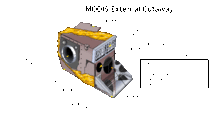Moderate Resolution Imaging Spectroradiometer
The Moderate Resolution Imaging Spectroradiometer (MODIS) is a satellite-based sensor used for earth and climate measurements. There are two MODIS sensors in Earth orbit: one on board the Terra (EOS AM) satellite, launched by NASA in 1999; and one on board the Aqua (EOS PM) satellite, launched in 2002. MODIS is succeeded by the VIIRS,[citation needed] which was first launched in 2011 aboard the Suomi NPP satellite.
The MODIS instruments were built by Santa Barbara Remote Sensing.[1] They capture data in 36 spectral bands ranging in wavelength from 0.4 μm to 14.4 μm and at varying spatial resolutions (2 bands at 250 m, 5 bands at 500 m and 29 bands at 1 km). Together the instruments image the entire Earth every 1 to 2 days. They are designed to provide measurements in large-scale global dynamics including changes in Earth's cloud cover, radiation budget and processes occurring in the oceans, on land, and in the lower atmosphere.
With its high spatial resolution but low temporal resolution, MODIS data are useful to track changes in the landscape over time. Examples of such applications are the monitoring of vegetation health by means of time-series analyses with vegetation indices,[3] long term land cover changes (e.g. to monitor deforestation rates),[4][5][6][7] global snow cover trends,[8][9] water inundation from pluvial, riverine, or sea level rise flooding in coastal areas,[10] change of water levels of major lakes such as the Aral Sea,[11][12] and the detection and mapping of wildland fires in the United States.[13] The United States Forest Service's Remote Sensing Applications Center analyzes MODIS imagery on a continuous basis to provide information for the management and suppression of wildfires.[14]
MODIS utilizes four on-board calibrators in addition to the space view in order to provide in-flight calibration: solar diffuser (SD), solar diffuser stability monitor (SDSM), spectral radiometric calibration assembly (SRCA), and a v-groove black body.[16] MODIS has used the marine optical buoy for vicarious calibration.
The following MODIS Level 3 (L3) datasets are available from NASA, as processed by the Collection 5 software.[17]
Raw MODIS data stream can be received in real-time using a tracking antenna, due to the instrument's direct broadcast capability.[18]





